A key message of this site is that contemporary armies are unprepared for the challenges of operating in cities. In some respects, though, we are actually much less prepared now than in the past. Last year John Spencer offered a wish list of tools the US Army does not have but that he would want if sent to fight in a dense urban environment, as he did in Baghdad in 2007–2008. Ironically, there were weapons systems available in 1944 that were better suited to the problems of urban combat than those we have today.
By 1944 both Allied and Axis armies had paid in blood to discover what was needed to progress against a determined enemy who took advantage of the cover and concealment offered by buildings and presented a threat of constant ambush from three dimensions. While tactics differed between armies, some attack methods were constant. The essential tool for clearing was the grenade. Attackers had learned that they would lose a close-quarters marksmanship contest with lurking defenders unless every room and space was first blasted before entry to kill, or at least daze and deafen, anyone within. The building-clearing drill in Commonwealth armies was focused on supporting the “bomber” who, directed by the section commander, constantly tossed or dropped grenades ahead of the “entrymen.” Soviet Gen. Vasily Chuikov emphasized that in urban warfare, “you’ve got to pluck the enemy out with bayonets and grenades,” and directed troops to carry ten to twelve grenades and throw one first at every corner and doorway. Wehrmacht soldiers would tie their stick grenades in bundles to breach walls and use poles to get them behind interior cover or to reach defenders in upper rooms or stairwells.
Yet, by 1944 all the armies had also learned to minimize building-to-building and room-to-room fighting and exploit firepower. As the Soviets pushed west, Stalin’s Stavka, the Soviet high command, directed bypassing defended urban areas and even leaving escape routes open to avoid a close urban fight that reduced Soviet advantages in mass and firepower. When assault could not be avoided, Soviet forces applied their planning norms for extraordinarily heavy “annihilation” (unichtozhenie) levels of artillery bombardment. In the later battles for the smaller cities and towns of East Prussia this approach would turn the wood-and-brick buildings into a pile of rubble that buried the defenders: resistance often only lasted a few hours. In the bigger cities where buildings were more substantial, a doctrine of direct artillery fire was emphasized. Attacking Soviet infantry forces were not only accompanied by tanks but closely followed by medium and heavy guns to provide the direct fire that could systematically destroy buildings used as strongpoints. The Allies learned the same technique: after surrendering Aachen, the German garrison commander said, “When the Americans start using 155s as sniper weapons it’s time to give up.”
Immediately after D-Day the Allied forces also sought to use air bombardment to collapse resistance in urban objectives, despite having already discovered at Monte Cassino and other towns in Italy that if the defenders had underground shelter, the air bombing provided the enemy with a massive obstacle impassable to armored vehicles. The Commonwealth forces encountered the same challenge when, to support the breakout from Normandy, the Royal Air Force bombed the French city of Caen. The military problem created by the rubble was compounded by the political problems flowing from the number of French civilian casualties. The resulting requirement for “restraint” to reduce civilian casualties came at a time that the Allies were also struggling with shortages of manpower and becoming increasingly sensitive to their own casualties. Commonwealth armies determined that a man should not be sent to do what a machine could achieve, and increasingly relied on a variety of specialized armored engineering vehicles that had been designed to overcome the German coastal fortifications and obstacles. During the advance into Belgium, the Netherlands, and Germany, tanks equipped to fire demolition charges and those fitted with flamethrowers proved a potent combination for collapsing an urban defense.
By this stage in the war, the Germans were now usually on the defensive, for which they had discovered their simple, tough self-propelled guns were a force multiplier in both urban defense and counterattack. They proved particularly valuable in the latter, by reducing the requirement to conduct infantry counterassaults against determined defenders in buildings, which invariably caused heavy casualties. During the battles in the Netherlands to eject British and Polish airborne forces from Arnhem and Oosterbeek, or in Warsaw to destroy the Polish Home Army, the Germans learned to bring the self-propelled guns up and systematically destroy each defended building from the roof downwards. In the same battles they also used fire, deliberately burning large parts of the Dutch towns to variously evict the paratroopers or turn them into hot ruins that could not be occupied.
The assault and engineering vehicles and some specialist infantry weapons that were available in 1944 might still prove remarkably useful if modern military forces had them today. Certainly, updated versions or new systems able to provide equivalent effects would offer significant capabilities that we do not currently possess. Let’s have a look at some examples.
Sturmtiger direct-fire assault mortar. The most striking urban assault system of World War II was the Sturmtiger—a sixty-eight-ton behemoth built on a short Tiger chassis with nearly five inches of armor on the front. It mounted a huge “mortar” that fired 380-millimeter rocket projectiles adapted from a naval depth-charge system. Only fourteen rounds could be carried and loading the 770-pound rounds required re-elevation of the barrel, use of a winch, and the efforts of the entire crew of five. However, the thin-walled projectiles had a massive explosive fill: 275 pounds for the high-explosive rounds, which were each capable of flattening a large building, while the slightly lighter hollow-charge rounds would breach eight feet of concrete. The short-barreled rocket system was inaccurate at longer ranges. For example, it failed to hit the US-captured bridge at Remagen when used at its maximum range of eight thousand yards; however, a single projectile incidentally knocked out three Sherman tanks. For protection against infantry at close range the Sturmtiger not only had a machine gun and firing ports for submachine guns, but a Nahverteidigungswaffe—a dedicated, close-in defense system that launched fragmentation grenades derived from “Bouncing Betty” S-mines—to detonate a few meters above the hull, throwing fragments in all directions. Like many other German innovations, the Sturmtiger appeared late in the war and in limited numbers, and as an assault weapon for an army on the defensive its potential remained largely unrealized. It was employed to devastating effect in the destruction of the Polish Home Army in Warsaw, but its lack of agility among rubble and craters meant it was generally employed from several hundred metres behind the leading German troops.
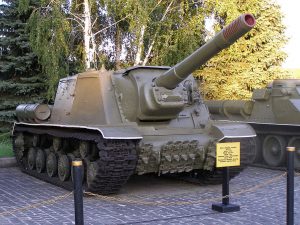
ISU-152 self-propelled gun, on display at the Museum of the Great Patriotic War, Kiev. (Credit: V. V. Chobitok)
Self-propelled guns and the ISU-152. The Soviets and Germans fielded large numbers of “turretless” armored self-propelled guns during World War II, with the SU-76 and StuG III becoming the respective infantry-support workhorses of their armies. Their three-inch-equivalent high-velocity guns were effective against armored vehicles and could penetrate double-brick walls. Both armies would use them to move closely behind advancing troops to provide fire support as soon as resistance was encountered. The effects of their impact-fused, high-explosive shells would suppress defenders, but to eliminate or drive out determined defenders from a substantial building by fire was a slow process, often requiring its systematic destruction from the top down. Defenders often chose substantial concrete and stone buildings as strongpoints, so to breach their walls and neutralize those within a bigger explosive round proved necessary. The Germans developed the Sturmpanzer IV with a potent 150-millimeter short-barreled gun, but the forty-three-ton Soviet ISU-152 assault gun was probably the best of its class. It had thick frontal protection and was reliable and relatively agile. The 152-millimeter high-velocity gun could punch shells through substantial concrete walls to detonate its twelve-pound explosive payload within. It proved a devastatingly effective close-support weapon in the urban battles up to and including Berlin.
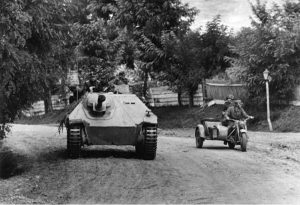
Jagdpanzer Hetzer in Hungary. (Credit: Bundesarchiv / Kreutzer, Wilhelm)
Hetzer light tank destroyer. At the bottom end of the scale we find an interesting, “asymmetric” German armored vehicle that, while remembered as a utilitarian anti-armor platform, proved remarkably useful in urban combat. The Hetzer (JgPz38) light tank destroyer was small—weighing a mere fifteen tons—and reliable, and had a potent 75-millimeter gun that would defeat virtually any Allied tank at urban ranges. While its side armor was thin and it needed infantry protection because of poor crew visibility, it was an ideal ambush weapon that could be readily hidden in urban cover or even within buildings. In offensive operations such as the suppression of the Polish uprising in Warsaw it proved a surprisingly effective platform for working closely on the street with German infantry sections. Infantry troops could advance using the vehicle hull for protection while the remote-controlled overhead machine gun provided fire support on contact. A combination of the low height and a commander’s hatch that opened angled to the rear made it possible for an infantryman to climb on the vehicle to communicate with the crew while remaining protected. The Hetzer remains an archetype for a simple infantry close-support platform.
Churchill tank funnies: AVRE, Crocodile, and Kangaroo. The British Churchill tank was slow and initially mechanically unreliable, yet later models were as well armored as a German Tiger. A low center of gravity and good hull clearance meant it could climb steep slopes and cross rubble that few other vehicles could attempt. It performed well in its intended role as an infantry support tank, and outstandingly as the basis for a family of specialist vehicles, often referred to as “funnies.” A particular advantage was that it had forward access hatches between the tracks on both sides, allowing soldiers to dismount in relative safety. This feature was exploited in the turretless “Kangaroo” infantry carrying version as well as in engineer vehicles where dedicated demolition crewmen were carried to place explosives or smoke pots by hand. Variants included bridge-layers, mine-clearing flails, and explosive hose launchers, but two other versions working together proved devastatingly effective in urban fighting in northern Europe after D-Day.
The Churchill Armoured Vehicle Royal Engineers (AVRE) was equipped with a 290-millimeter spigot mortar that fired a forty-pound bomb containing twenty-six pounds of high explosive. While the maximum range was only one hundred yards, the weapon reliably knocked out reinforced concrete bunkers and collapsed buildings.
The Churchill Crocodile had a hull-mounted flamethrower supplied with gas-pressurized fuel from a trailer, with a flame range of 120 yards. In street battles in France, the Netherlands, and Germany, strongpoints would be abandoned when an approaching Crocodile fired a demonstration burst. If the defenders did not yield, the Crocodile and AVRE would close up in the resulting smoke, the AVRE would fire a bomb to “crack” the position, and the Crocodile would flow flame into the breach or onto the rubble. While the effects of flame weapons are undoubtedly horrific, the British and Canadian use of specialized armored vehicles to evict defenders rather than systematically clear buildings in detail not only reduced their own and enemy casualties, but avoided the previous reliance on heavy bombardment, which invariably caused many civilian deaths. Consequently, the use of specialist engineer vehicles, including flamethrowers, can counterintuitively be argued to represent a restrained approach that better satisfies the humanitarian-law requirements of proportionality.
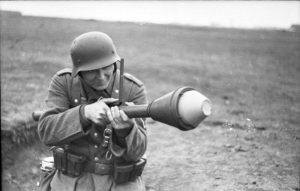
Soldier with Panzerfaust. (Credit: Bundesarchiv / Gronefeld, Gerhard)
The Panzerfaust as a wall-breaching weapon. The Panzerfaust was a simple, handheld recoilless infantry anti-tank weapon first fielded by the Germans in 1943. It was aimed with a simple peep sight while holding the launching tube under the arm. On firing, there was a backblast of several meters as the projectile launched, stabilizing fins popped out, and the fuse was armed. When the projectile impacted, the detonation of the hollow-charge warhead collapsed the conical metal liner and blasted it through the target. Early models had a range of thirty meters and would penetrate about 140 millimeters of steel armor, and in later models this increased to 220 millimeters. More modern hollow-charge warhead designs yielded almost three times this penetration for a similar amount of explosive, mainly by distributing the explosive further back and increasing the distance from the target at which detonation occurs. However, the penetration hole of Panzerfaust warheads was larger, while shockwave within the target material, frontal spalling, and blast were greater. This meant that when a Panzerfaust projectile struck a wall, especially interior brick walls, it would often create a man-passable breach—unlike, say, a contemporary RPG-7 or M72 HEAT round, which make neat, small holes. Furthermore, the Panzerfaust could be readily fired from cover, one-handed, around a doorway or window against an interior far wall. This capability was not only exploited by the Germans. In the urban battles as the Soviets fought toward Berlin, they distributed captured stocks to their storm detachments in order to conduct explosive mouse-holing during assaults.
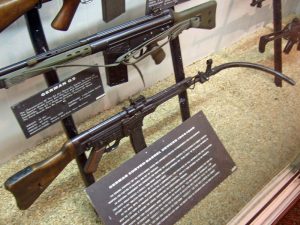
Sturmgewehr 44 with Krummlauf. (Credit: Joe Loong)
Sturmgewehr 44 and Krummlauf. The German Sturmgewehr 44 was the innovative forerunner of modern selective-fire assault rifles. With a thirty-round magazine and firing a new “intermediate” 7.92-millimeter short round to an effective range of three hundred meters, it revolutionized infantry tactics—and inspired Kalashnikov’s design. Concurrently, the Germans developed a curved barrel attachment, the Krummlauf. This allowed the Sturmgewehr 44 to be fired from inside an armored vehicle at enemy infantry attempting to hand-place explosive charges—a constant danger in dense terrain. The infantry version of the attachment had a mirror sight that allowed a soldier to fire around a corner or from inside a trench while remaining behind cover. Even after initial technical problems were addressed, the attachment only had a life of a couple of hundred rounds, bullets often broke up in the device, and it was unlikely to achieve a hit on a target beyond one hundred meters. These were great disadvantages in open terrain, but less so in urban, close-quarters fighting, when the bullet disintegration increased hit probability and lethality. There are reports of a few weapons being used in the battle for Berlin and the Soviets were sufficiently impressed to trial a curved barrel version of the PPshK submachine gun (and later the RPK LMG). However, the great potential of the Sturmgewehr 44 with Krummlauf was to address a problem that barely existed at the end of World War II—to reduce risk to attackers during building clearing under restricted rules of engagement.
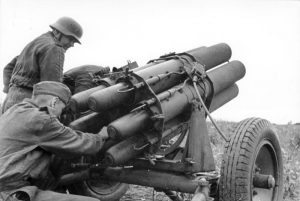
German soldiers loading Nebelwerfer 41. (Credit: Bundesarchiv / Nieberle)
Nebelwerfer rockets. During World War II the Germans progressively fielded a family of light rocket artillery of increasing size and range: the Nebelwerfer series. Rocket propulsion allowed a thin-walled projectile with a relatively large smoke composition or high-explosive payload, the latter giving blast effects equivalent to larger artillery rounds. The most-produced 1941 model was a six-barrelled, two-wheeled towed launcher that ripple-fired 150-millimeter high-explosive or smoke projectiles up to 6,900 meters. A battery of six launchers could deliver its thirty-six rounds within twelve seconds, either inflicting a devastating barrage or rapidly smoking off a substantial area of the battlefield. The latter is an often-forgotten but crucial capability for urban operations—not only for the break-in urban battle, but to blind snipers who could otherwise often bring an attack to a halt. The Nebelwerfer was not intended for direct fire, but soldiers developed crude but effective aiming techniques and, on occasion, were able to hit and destroy tanks. In the 1941 model, the rocket motor was at the front of the spin-stabilized projectile, ensuring that a high-explosive warhead would normally be above ground on detonation, thus giving maximum fragmentation spread. If delay-fuzed ammunition was fired against buildings, the initial impact of the motor assembly assisted the warhead in penetrating walls to burst beyond. The larger, longer-range, later-model systems were less portable and therefore less valuable in urban combat; however, some projectiles could be fired from the frames or cases in which they were delivered. This meant that it was possible to manhandle these rocket projectiles within buildings to reach firing positions, such as the upper stories of buildings, where it was not possible to take conventional guns or tanks. Having been aimed at the target, the rocket would then be fired electrically from a distance, avoiding the risk of return fire to the now-obvious firing point. The Soviets used individual Katyusha rockets in a similar manner, firing them from rails propped between furniture and windowsills.
The Rammpanzer. Reflecting the experience of street fighting in Stalingrad, the German high command generated a requirement for an armored vehicle to clear obstacles and physically breach urban objectives by ramming. (The potential for tanks to assault buildings in this way had long been known, and occasionally practiced with the early-model Panzers, which were smaller, with barrels that did not protrude beyond the front of the hull. However, as vehicles became taller, the risk of either jamming against ceiling beams or dislodging them and collapsing the building on top of the vehicle inhibited commanders. Furthermore, they could no longer slew their turrets within buildings.) The concept was to mount a turtle-like, heavily armored shell on a turretless version of a Tiger tank. This had a breaching prow at the front and a sloped roof to disperse falling rubble to the sides. Significantly, the overhead armor was fifty millimeters thick while the frontal and side armor was thirty millimeters. The Rammpanzer had thicker top armor than that of the tank on whose frame it was built. This reflects the strength needed to survive falling rubble, but also recognizes the threat from infantry anti-armor weapons fired or thrown from above in urban combat. It appears that this double layer of substantial armor with an air gap would have given unprecedented protection against shaped-charge grenades and satchel charges, which were the main threat at very close quarters. While there would certainly have been room within the vehicle for a number of assault infantryman, the hatch layouts do not suggest this was intended. The records show that Hitler personally ordered the development of three prototypes and suggest that they were built, although there is some dispute and no genuine photographs have been found. Certainly they did not see action. Nevertheless, the concept itself may have some merit, although both Allied experience with armored bulldozers and the Germans successful use of turretless “Raumpanzer” tanks with angled dozing blades to clear streets in their bombed cities suggest that the addition of a similar movable blade would avoid the tank drivers’ problem of becoming “piered”—jammed on sections of wall or large rubble beneath the hull.

Cultivator No. 6, an underground tank designed to travel across no-man’s land in a trench of its own making.
“Cultivator” trenching machine. During the early “phoney war” stages of World War II the prospect of conducting deliberate attacks against extensive fortifications akin to the trench warfare of World War I loomed large. Possibly inspired by Austrian rail-mounted trench-digging machines from that war, Winston Churchill directed the development of machines that would advance just below ground level, excavating its own trench. Infantry and armored vehicles would follow in the trench and use the machine as a ramp to emerge unscathed on the enemy objective. While large numbers were initially planned, eventually only a few of the narrower infantry version were built by the Royal Navy and none were ever used in action. The machine, codenamed Cultivator No. 6, was massive—seventy-seven feet long (in two sections), ten feet high, and seven feet wide—and excavated the lower part of the trench with a large cylindrical cutting blade and displaced the soil above this with a plow arrangement. Even above ground it could only move at three miles an hour, and its turning radius of a mile proved problematic. Nevertheless the “Cultivator” did demonstrate the technical feasibility of a military vehicle capable of moving just below ground level. This, reinforced by developments in small-tunnel boring technology, strongly suggests that it would be possible to build more compact unmanned machines that could operate in a broadly comparable fashion in urban terrain.
Insights and Inspiration from 1944?
It is sobering to reflect that there were technologies and capabilities available in 1944 that are now abandoned and forgotten, yet might today give decisive advantage in an urban fight. A large-caliber “mortar” capable of indirect and direct fire—something like the 380-millimeter launch on the Sturmtiger—would offer the ground commander an assured form of destructive effect that is currently delivered by guided aircraft bombs. Furthermore, inert projectiles would offer reliable breaching of substantial walls without the blast hazard of other breaching munitions. Effects can be delivered within seconds of the target being identified, largely avoiding the approval processes for airstrikes. Certainly, such a capability avoids the commitment of a squadron of strike aircraft and refuelling support that is required to keep an armed plane permanently on station.
Self-propelled assault guns such as the Sturmtiger and the ISU-152 were also designed for the close fight, with very heavy armor, and were resistant to the kinetic projectiles of the lighter anti-tank guns they might encounter in an urban area. While shaped and hand-placed explosive charges remained a threat, the vehicles were tough enough to be able to reduce this vulnerability by advancing into their own side’s bombardment—or in the case of the Sturmtiger, by using its own mine discharger to suppress infantry nearby. These vehicles were also extraordinarily robust compared to modern self-propelled guns, which are generally only armored against small-arms fire and shell splinters. This meant that provided the commander was alert for under-floors or cellars and took care to avoid striking main supports, such vehicles could be driven straight through buildings. This toughness was well illustrated during the Chernobyl disaster, when a number of old ISU-152s were used both to ram entries for specialists and as bulldozers to bring down irradiated buildings, literally collapsing walls and roofs on themselves with impunity.
The capability provided by small self-propelled guns, as well as tanks equipped with flamethrowers or demolition guns, would be extraordinarily valuable today—with the clear acknowledgement that while flame weapons are not explicitly prohibited (except against civilians), domestic and international perceptions make their use problematic. It would also seem that the lessons learned using these manned vehicles during World War II might usefully inform requirements for future platforms. For example, the utility of the forward hatches on the Churchill tank was that it allowed sappers or infantryman to dismount while protected, and this is incidentally the exact capability that Israel has developed on some of its specialist engineering vehicles derived from Centurion tanks, where there is a forward dismounting in the glacis plate. Importantly, all three of these capabilities—a large-caliber mortar, self-propelled assault guns, and unique tank capabilities—could now be provided by unmanned armored platforms. In particular, spigot mortars offer a way to provide a small tele-operated platform with a very substantial warhead for close-range use.
While Israel has developed and licensed a family of door– and wall-breaching munitions, there has been a curious failure by contemporary armies to adopt these—or their equivalents. Without experience and confidence in their use, it is risky to assert that they would offer radical advantage in building clearing. Nevertheless, the occasional surviving account of how Russian “storm groups” freely used stocks of captured Panzerfausts to conduct simultaneous multi-entry, through-wall assaults concurrently in cellars and upper stories suggests such potential. The Krummlauf concept—allowing the soldier to engage around cover while remaining hidden—has now been delivered by devices such as the “corner shot,” as well as sighting systems where an image from a rifle held around cover is projected to a head-mounted display. In contrast, there do not appear to be any available equivalents of Nebelwerfer launchers and projectiles. While enhanced blast munitions from shoulder-fired launchers arguably offer dramatically improved terminal effects, these require firers to expose themselves to engage. A direct-fire system that is fired remotely (or even electronically) after setting up, from cover, has great utility in the urban fight.
Possibly the most thought-provoking of the 1944 technologies worth considering are not lethal. A very tough armored vehicle that can move through buildings and obstacles would mitigate some of the tactical challenges presented by the urban fabric. The British Cultivator No. 6 demonstrated that a mole-like trench excavator that advances through an urban area just below the surface is technically possible. A tunneling machine used by ISIS showed that this can be done with modest engineering capability. Adding the capacity to lay supports on which to spread excavated soil and rubble to form a tunnel appears straightforward. Yet the real significance of these examples is to show that it is possible to build cutting machines for both manned or unmanned armored vehicles to enable them to move through structures by cutting their way rather than ramming.
All of the capabilities described and discussed above had limitations in 1944, and many would be more vulnerable on today’s battlefield. Nevertheless, on the streets of Europe commanders had tactical options that we do not have today—options that saved their soldiers’ lives—and would still have been valuable in Marawi or Mosul. It is an indictment that, with few exceptions, we have not exploited contemporary technologies to deliver the special types of effect that offer decision on the urban battlefield. We need to fix that.
Dr. Charles Knight has served with British Army, RAF and several overseas forces and is a lecturer in Terrorism, Asymmetric Conflict & Urban Operations at Charles Sturt University. He developed UK training in Soviet urban doctrine, subterranean recce capability & urban anti-tank guided weapon procedures. He spent a decade in Special Operations development, commanded 2/17 Royal New South Wales Regiment, served in 1 Commando Regiment and developed Australian Army urban doctrine.
The views expressed are those of the author and do not reflect the official position of the United States Military Academy, Department of the Army, or Department of Defense.
Featured image: Nebelwerfer firing in Warsaw (Credit: Bundesarchiv, Bild / Leher)

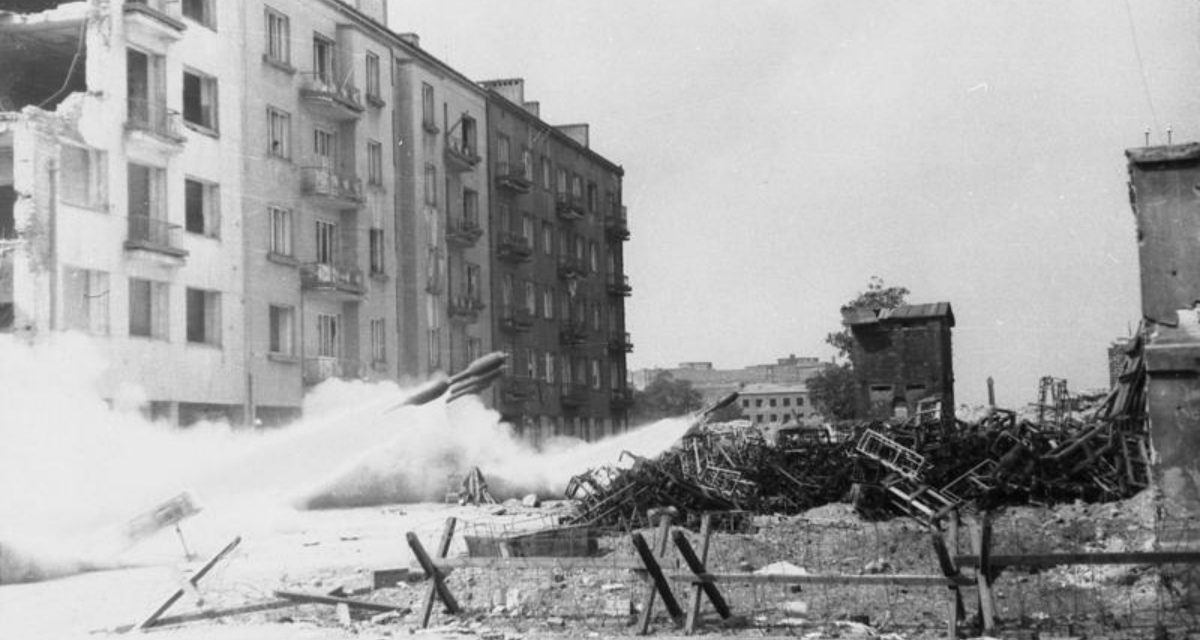

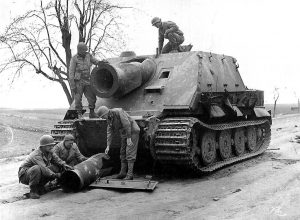
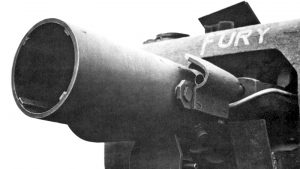
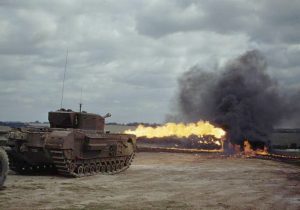
What the author promotes is having more variety of weapons at the arsenal's disposal, something that I have also been vouching for a long time. To have more arrows in the quiver makes sense, but these days, the West prefer quantity than variety of arms unlike the Russians and the Chinese which have vast numbers of many different types of weapons in varying sizes.
I still don't see how in 2020, the need for Direct Action fire mostly with bullets is the basis of winning Military Operations in Urban Terrain (MOUT). As this article shows, high explosives and flame were in more prevalent use during WW2 urban combat. The M4 carbine, SAW and M240 machine gun, shotgun, and AT-4 rocket make for dubious "winning weapons" in the chaos of MOUT. Yes, they have been used extensively in MOUT, but if these weapons cannot uproot the enemy, then the squad and platoons are left with little other weapons options besides CAS and heavy armor. These weapons mean that soldiers usually have to get up close and personal to terminate the enemy.
Ironically, the USA has developed non-lethal weapons for MOUT such as the dazzler, LRAD acoustic, heat ray, tear gas, drones, sticky goo, slippery liquid, curving bullets, etc. These still aren't widely used or produced and it seems that the West's destructive firepower has diminished since WW2 and even Vietnam (106mm Recoilless Rifles).
To remedy, the 84mm Carl Gustav Recoilless Rifle and a return to 40mm high explosives such as the M36 Milktor is a good start, as are flamethrowers and incendiaries. The GWOT and Syria have shown that MOUT leaves cities in rubble so the preservation of buildings is highly dubious now. If the West is to win in MOUT, then the use of explosives and highly destructive weapons is required more than just bullets. Drones and robotics could contribute to the offensive.
The logic of this article means that instead of sending a soldier with a rifle in, send a rocket, shell, flame, or a high explosive instead to save the soldier's life. Syria and Iraq has shown that MOUT leaves little left intact of cities.
I sense a thread there… lots and lots of "dumb" explosives. The Soviets believed in using lots of explosive to kill the opposing force. Therefore, if you want the Grozny kind of solution to urban operations, bring on the explosives.
I agree with Maeda. The WW2 answer to urban warfare was the consistent application of high explosive and the willingness to accept or simply ignore gross levels of civilian casualties and collateral damage. And infamously from Vietnam, “It became necessary to destroy the city in order to save it.” Is this the answer to urban warfare in the modern day?
As Cicero said of Ancient Rome, “In times of war, the law falls silent.” Nations and people are willing to accept costs and use methods during wars which in other times would be considered completely unacceptable. There is a limit to this, obviously, but ultimately militaries become more morally and legally flexible in trying times.
Because the stakes are now lower than then, we must become more skilled, precise, and judicious with our firepower, and if we want to reduce casualties, then we instead must employ small numbers of highly trained and very technologically advanced units with a plethora of support by fires and intelligence.
The Ways we employ our forces are a result of our desired Ends, and we come up with the Means to make the mission happen.
I have a simple question, why? Urban warfare, street fighting, clearing buildings is not the answer. Modern warfare should be about maneuver. Hit the enemy at his weakest point, not his strongest point. By pass urban areas. Attack command and control. Do you want to win or destroy the enemy cities? Regardless of the weapons used urban warfare will always be costly in human lives lost.
Unfortunately, Peter is right. MOUT necessitates widespread destruction, especially when the occupiers have prepared urban positions for some time by constructing tunnels, for example, in order to hide their movements. This is an inescapable lesson from 20th century wars and recent ones, with the 2017 battles of the Old City of Mosul in Iraq and Raqqa in Syria being illustrative, as well as the ongoing battle of Bakhmut in Ukraine. Where there is heavy resistance, 80% of civilian structures will be damaged or destroyed and civilians who have been unable to escape, either through lack of means or being held hostage, will suffer terribly. In such circumstances, the only way to win is to prevent those cities from being taken in the first place. Of course, this is not always possible. If you must retake a city, you will necessarily destroy a large part of it. The only alternative to a battle, if it could be called that, is encirclement and a siege, of which Mariupol in 2022 is the latest example. Without a surrender, the death and destruction are the same.
The article addresses a point which should not go ignored. The over-reliance on air power is not only expensive but in a war with a near-peer enemy it is simply not guaranteed to be there when it is needed. It would leave soldiers with no other option but to go in by themselves and result in enormous casualties. The MBT has dominated for decades now but the main conception for its use, it must be said, was a war in Europe over relatively open terrain while precision weapons and drones were in their developmental infancy. At that time, cities and other urban centers were projected to be destroyed by nuclear weapons, whether tactical or strategic. The stigma against their use has held, mercifully, and with any luck will continue to hold in the future. It should also be noted that there is little practical difference between the prolonged use of precision munitions and carpet bombing or mass artillery bombardment of urban terrain. By the end, it all looks equally indiscriminate.
In any case, the use of heavy self-propelled guns should again be considered. 150mm guns or heavier are impractical to mount on MBTs but would find good use in urban terrain. While arguably overkill for anti-armor purposes, they have fulfilled this role historically and could do so again. Smaller SPGs and tank destroyers, however, have been replaced by MBTs and IFVs. AVRE-type mortars can be very effective against fortifications but are ill-suited against enemy armor and have suffered various problems with their operation, up to and including catastrophic failure. Most infamously, three Centurion AVREs exploded during training sessions in the 1991 Gulf war, and have not been used since. Incendiary weapons like flamethrowers should be avoided, because it would legitimize and proliferate the use of incendiary munitions. Flamethrowers and napalm did little to halt urban destruction in wars past, did not intimidate fanatical opponents into giving up their positions, and were hazardous to the soldiers using them. Nebelwerfer 41-type MRLS are also outdated when their role could be filled by drones; in no small part, they were terror weapons. The other suggestions aren't as important.
The main strength of heavy SPGs like the ISU-152 is that they were simple, robust, and effective platforms. A large caliber gun would necessitate the use of an autoloader or an increased crew size to compensate. Given the US' rocky history with autoloaders — see the M1128 MGS' recent failure — the latter is more likely. The M1128 MGS also demonstrates that, even today, you cannot graft a big gun onto an existing chassis without technical problems. If the assault gun is to be reintroduced, it would have to be a new design with a tight focus on urban operations as its raison d'être. In other words, a platform that's less technically complex and simpler to manufacture than an MBT, which is still better suited to that task. Suffice to say, desirable as this may be, it is unlikely. Copious use of explosives and drones is a more predictable development.
As a brief follow-up, the M10 Booker will be in service between 2023-2025, deflating my statement that MBTs and IFVs have won out. It's expensive, light, and packs a 105mm gun, but it is nonetheless slated to fulfill the role of infantry support against fortifications. While it is undoubtedly a highly capable vehicle, it's following in the footsteps of the M551 Sheridan, and as such may suffer greatly in urban combat where even MBTs have proven vulnerable. That said, it's introduction is an acknowledgement that infantry support needs to be on the ground in a contested environment.